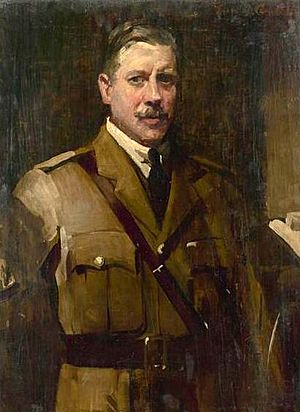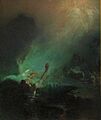John Longstaff facts for kids
Quick facts for kids
John Longstaff
|
|
|---|---|

A portrait of John Longstaff by George Coates, 1918
|
|
| Born |
John Campbell Longstaff
10 March 1861 |
| Died | 1 October 1941 (aged 80) Melbourne, Victoria, Australia
|
| Nationality | Australian |
| Known for | Painting |
Sir John Campbell Longstaff (born March 10, 1861 – died October 1, 1941) was a famous Australian painter. He was also a war artist, meaning he painted scenes and people from wars. John Longstaff won the important Archibald Prize for portraits five times. His cousin, Will Longstaff, was also a painter and war artist.
John Longstaff was known for being very stylish. He painted many portraits, especially in the early 1900s.
Contents
Early Life and Art Training
John Longstaff was born in Clunes, a town in Victoria, Australia. He was the second son of Ralph Longstaff, who owned a store. John went to school in Miners Rest and Clunes.
Even though his father wasn't sure about his art dreams at first, John's talent was clear. He studied art from 1883 to 1887 at the Melbourne National Gallery School. There, a teacher named George Folingsby recognized his great skill.
Studying Art in Europe
In 1887, John Longstaff won the first-ever travelling scholarship from the National Gallery of Victoria. This meant he could travel to Europe to study art! He won with his painting Breaking the News. He sold this painting for a good amount of money.
Before he left, he married Rosa Louisa Crocker. In September 1887, they sailed to London. In January 1888, they went to Paris, where John showed his art in a famous exhibition called the Paris Salon. Later, they moved back to London, where he painted many portraits.
John Longstaff came back to Australia in 1894. He received many requests to paint for people. He had a studio in Melbourne from 1897 to 1900. The National Gallery of Victoria bought his large landscape painting called Gippsland, Sunday night, 20 February 1898. In 1901, he travelled to London again and showed his work at the Royal Academy.
Painting During Wartime
During the First World War, John Longstaff became an official war artist for the Australian army. His job was to paint important officers and scenes from the war.
When he returned to Australia, he received many awards. He also held important positions, like being the President of the Victorian Artists Society in 1924. In 1927, he became a Trustee of the National Gallery of Victoria. In 1928, he was made a knight, becoming "Sir John Longstaff." He was the first Australian artist to receive this special honour.
Famous Portraits
John Longstaff was especially known for his portraits. In 1924, he met Jessica Harcourt, who was called "Australia's loveliest girl." He was so impressed by her beauty that he painted her twice. He thought she was "almost a perfect type of feminine beauty."
In 1929, he painted a portrait of the artist Ellis Rowan. This was the first time a portrait of a woman in Australia was paid for by people from all over the country. They wanted to honour her amazing qualities.
The Art Gallery of South Australia has his portraits of Paris Nesbit and The Artist's Wife. In 2012, an exhibition called Portrait of a Lady showed many of Longstaff's portraits of women at the Shepparton Art Museum.
About His Life
A book about John Longstaff's life, called Portrait in Youth, was written by Nina Murdoch and published in 1948. His 1920 portrait of Nina Murdoch can be seen in the National Library in Canberra.
Archibald Prize Wins
John Longstaff won the famous Archibald Prize for portraiture five times. Here are some of his winning paintings:
- 1925 - Portrait of Maurice Moscovitch
- 1928 - Portrait of Dr Alexander Leeper
- 1929 - W A Holman, KC
- 1931 - Sir John Sulman
- 1935 - A B ('Banjo') Paterson
Images for kids
-
Breaking the News, 1887, Art Gallery of Western Australia
-
Lady In Grey, 1890, National Gallery of Victoria
-
The Artist's Wife, 1896, Art Gallery of South Australia










